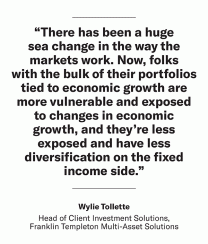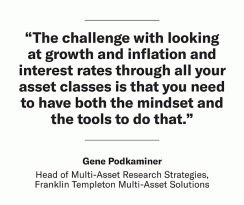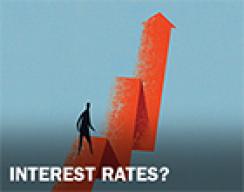The investment experts at Franklin Templeton spend a lot of time speaking to chief investment officers about “What if . . .” That is, the most beneficial discussions come from exploring the implications of what might happen—not guessing the future—and being prepared for those risks.
In the following conversation, two key players at Franklin Templeton Multi-Asset Solutions—Wylie Tollette, Head of Client Investment Solutions, and Gene Podkaminer, Head of Multi-Asset Research Strategies—contemplate the “what if” of interest rates in an exchange where you will hear about inflection points, and harken back to the good old days of the 1950s and ‘60s.
Gene Podkaminer: Looking back further than the most recent 10 years, we’ve seen this secular decline in interest rates over the past 40 years. At some point, we’re going to hit an inflection point where we’re going be learning a lot about what it means to live in a rising rate environment. We don’t have a lot of good history to anchor that on. Episodically, over the last two centuries there have been periods when interest rates have risen. It will be interesting to see how market participants react now that we have more developed capital markets, and how central banks react to rising interest rates and the kind of feedback that produces for investors.
Tollette: If you look back to the 1950s and 1960s, the typical institutional investor had a lot more fixed income in their portfolio.
Podkaminer: Almost their entire allocation was in fixed income.
Tollette: Exactly. They were yield-focused investors, and fixed income provided a relatively secure, five-, six-, even seven-percent annual yield. It was solid. It was reliable. It was fairly low-risk. It didn’t require a ton of resources, research, or asset allocation activity.
Podkaminer: It was tied closer to their liabilities as well. You can’t look at fixed income in isolation from equities. In the 1950s, and in the ‘60s as well, there was a real ability to substitute fixed income for equity because fixed income gave you pretty healthy returns without taking on a ton of risk. Equities gave you good returns too, but they were substantially riskier. There’s a concept in microeconomics called the substitution effect, which can be summed up in short by saying if the candy I want isn’t on sale, maybe I’ll get something sweet that is on sale. You used to be able to do that between fixed income and equities, but over the last couple of decades, you really couldn’t. If you wanted any sort of substantial return, either you had to hold equities, or you had to go far out in credit space and hold below-investment grade high-yield bonds or emerging market debt.

With that changing, it will be very interesting to watch how investors react when yields start to climb. If they climb slowly and predictably, I think investors can react and move into an environment where fixed income has a little bit more yield and a little bit more annual return expectation. That could be healthy overall for the financial markets in the long term and provide a little bit more balance in return expectations across these macro risk factors. However, the process of adjustment can be disruptive and unpredictable.
Podkaminer: What type of shock do you think would drive a re-rating of interest rates in developed markets?
Tollette: It doesn’t take much change in expectation. I would say that if one of the Fed’s dot plots either falls off or goes higher by 25 basis points, you would see a re-rating certainly across the Treasury markets in the U.S. and in sovereign markets. Potentially, even changes in expectations smaller than 25 basis points could cause re-rating.
In the emerging markets with typically more volatile rates, you’d probably need something more like a 75 or 100 basis point expectation adjustment to see a re-rating. Fixed income is said to have a mathematical elegance to it, and that’s true, it does. A small change in rate expectations can cause a dramatic impact.
Now, if the actual rates end up close to expectations over time and that rate adjustment process is smooth, then we might not see dramatic re-ratings. However, any dramatic change in expectations around that rate structure and that yield curve can make the fixed income market volatile. People think of it as a low-volatility asset class. That's not always the case. For example, look at the Treasury bond from 1978 to 1985. It was just as volatile, if not more volatile, then equities.
Podkaminer: What we’ve been seeing more recently is that when there are terrible days in equities, usually you see that impact on the other side of the street with Treasuries. Imagine a world where: if instead of that kind of reaction an investor could actually say, “Okay, I’ve got some fixed income. It’s producing a reasonable yield. Maybe I don’t need this equity instrument over here because I can actually fund some of my obligations with it.” We’ll see.
Tollette: We’ll see. It will be very interesting. Again, sitting in the CIO seat, I think the first thing I would plan to do is to really analyze my portfolio, and of course, understand my total exposure to economic growth-related risks. Not just across equities; but as Gene said, across all my asset classes. The next thing is to understand your exposure to unexpected changes in rates. Again, not just across fixed income, where that is fairly mechanical and mathematical, but across every asset class—real estate, private equity, real assets.
Podkaminer: That is the hard part. When we talk about “across every asset class”, it’s tough to understand the duration or the interest rate sensitivity of equities.
Tollette: You can’t mathematically calculate it.

Many organizations treat equities, fixed income, private equity, hedge funds and other alternatives as distinct disciplines. When they go out to lunch, do they talk about what drives risk across their different disciplines? Only the CIO might see how much risk she is taking in, say, interest rates within her equity portfolio. That’s what I think is so fascinating about multi-asset class investing: by definition, you have to tear silos down and combine everybody together and say “look, we have a common risk budget to interest rates, or to inflation, or to global growth.”
Tollette: Where do we think we should we spend that risk budget?
Podkaminer: All of these investments contribute to that risk budget. Let’s make a rational decision about how to do it. That’s a huge challenge.
Tollette: That’s the asset side challenge for CIOs. Interest rates have a direct and mathematical impact on predictable types of liabilities like pension obligations or insurance obligations. If you know that your liabilities are mathematically driven by changes in rates and rates are going up, there is the potential to bring liabilities back down to earth. You need to make sure that’s properly evaluated on your asset side, too. Matching those things and understanding that mismatch—the volatility of the net deficit or surplus that you have from the funding perspective—can really be a dramatic influence in the way you structure your portfolio. That said, many people don’t think about that until a sudden, unexpected shift in rates occurs. Then you see that your funded ratio has shifted in a way that you didn’t expect. These are all things that should be considered before a sudden shift does happen.
Podkaminer: The money is for something, and you have to be concerned about how your portfolio reacts to interest rates. This means your assets and your liabilities together, because you may have had very healthy returns, but in a scenario where your liabilities have outpaced those returns. When you put assets and liabilities together, what you might see is your overall position has weakened even though you’ve had fantastic returns on the asset side. Imagine if interest rates do jolt up and the performance of your asset portfolio is impacted in a negative way. Maybe that’s okay because your liability, your future liabilities, have now come down. Net, you’re doing okay. It would be nice to know that in advance, to be able to make an explicit decision about that scenario rather than backing into it implicitly and waking up one day and saying, “Wow, my asset values really came down, but you know what? It’s all good because in surplus space, I’m doing fine.”
Wylie and Gene are happy to speak to you about your “what if” scenarios. Feel free to contact them at solutions@franklintempleton.com:
Wylie Tollette, CFA, CPA
Head of Client Investment Solutions
Franklin Templeton Multi-Asset Solutions
Gene Podkaminer, CFA
Head of Multi-Asset Research Strategies
Franklin Templeton Multi-Asset Solutions
More in the series "What if there are shocks to ... "

Franklin Templeton
| 
Franklin Templeton
| 
FT demographics
| 
Franklin Templeton
|

Franklin Templeton
| 
FT-global growth
| 
interest rates
| 
FT
|
Disclaimers
This material is provided for informational purposes only and nothing herein constitutes investment, legal, accounting or tax advice. This material is general in nature and is not directed to any category of investors and should not be regarded as individualized, a recommendation, investment advice or a suggestion to engage in or refrain from any investment-related course of action. All information is current as of the date of this material and is subject to change without notice. Any views or opinions expressed may not reflect those of the firm or the firm as a whole. Franklin Templeton does not accept any responsibility to update any opinions or other information contained in this document. This material may include estimates, outlooks, projections and other “forward-looking statements.” Due to a variety of factors, actual events may differ significantly from those presented.
CFA® and Chartered Financial Analyst® are trademarks owned by CFA Institute.
For US Residents Only
© 2018 Franklin Templeton Investments. All rights reserved.






